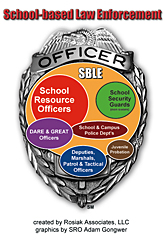I am often asked by secretaries, “What can I do to help with security and safety here at Ontario Schools?” I also recently presented the following ideas to secretaries from surrounding school districts in Richland County at a Mid-Ohio Educational Service Center conference. Most of them came from districts without SRO’s. These behavior-control methods can be used by anyone in the front office to strategically control visitors even after they have gained entrance into the building. So, secretaries……
Before you buzz that stranger into the building, before they brief you on who they are or why they are there, and before you get their visitor badge ready, consider these tips and strategies on successful visitor controlled access to your building.
First and foremost, you are the gatekeeper even if you do not have limited access buzzers at the door. You are in control of who enters your building. It's ok to say “no”, “hold on”, “standby”, etc. If you do not know who the person is or feel comfortable with their presence, you can easily get an administrator to have them checked out. Why allow them any further into the school building even if they are already in the office?
Although superintendents want you to be the smiling, welcoming and gracious host that would make even Martha Stewart jealous, they do not expect you to throw common sense to the wind. On any given day across the state, divorced parents, non-custodial in-laws, and pedophiles are hoping to make contact with your students, if you would just let them. Make sure beyond a reasonable doubt that they have a legitimate, legal reason to be interrupting your busy schedule. And if they are intoxicated (buzzed), impaired or otherwise undesirable, then simply refuse them service and send them on their way (your superintendent will understand).
Secondly, let us assume they have made it past the front door or were already in the building, but for some reason they are agitated. Irate parents, upset teachers, even injured students can be de-escalated. Have them brief you on what is upsetting them, “all we want are the facts, ma’am” as Sgt. Joe Friday would say. Look for the clues, listen for the indicators of what is behind their irritation.
One skill we can utilize is active listening. We have two ears and one mouth, we are meant to listen to the other person. Sometimes, just the mere attention to a person’s troubles can help them deal with the stress, annoyance or minor injury (whether physical or emotional). Active listening includes eye contact, paraphrasing or clarifying what they just said, or showing empathy (not sympathy) to their struggle. Many a written report has been averted by an officer just listening and letting the person know that someone cares. Nodding your head and an occasional “yes” or “I understand” can show the frustrated individual that you are paying attention.
Another source of inspiration comes from Dale Carnegie who wrote How to Win Friends & Influence People. He has numerous tips on managing even the most contancorus individuals. Here are just a few: become genuinely interested in other people, smile, a person’s name is the most beautiful sound to them in any language, talk in terms of the other person’s interests, see things from the other person’s point of view, and make the other person feel important—and do it sincerely. Fellow police officers have used these techniques catching more flies with honey than vinegar.
Finally, if they have passed your in-depth interrogation, hand them a visitor’s badge and send them on their way. However, if they refuse to heed your disarming persona, then it may be time to call in “the Badge.” Even if your school does not have a SRO, police officers working the street do not mind making contact with you in the school office if there is a situation.
As an SRO, I have been called to the office for divorced parents who were screaming over their child, referral to children services, a suspicious package left by an unknown adult for a student, and even a teacher whose soon-to-be ex was threatening to disrupt the school day. And for missing students, if the administrator cannot locate the child in a relatively short amount of time, do not delay in contacting law enforcement. For every hour that child is missing, the chance of getting them reunited with their custodial parent dramatically declines.
What can you share with the police? Any detail that your school policy says is “directory information” is fair game. This typically includes name, address and phone number. Some policies allow dates of attendance and photo as found in a yearbook, but will not include discipline records, IEP or other diagnoses made strictly for educational purposes. In return, police may be able to share with your administration team items like previous juvenile arrests or known associates of the student outside of school. At the end of the day, if we have to get the handcuffs out, I rely on what Rookie Jim Reed once said on Adam-12, “You just have to know how to arrest them and still make them like you. We call it technique.”
I share these tips in hopes that you and your administrative team can create a safer, more controlled atmosphere within the school environment. Volumes have been written on how to manipulate and persuade the unmanageable, too much for this article. However, these few words are a great place to start your new journey into winning friends and influencing people.
The Safe Schools Journal, OSROA, Spring 2013, pg 25-26

